Why do we lift? BECAUSE I SAID SO! Blog over, conversation done. We’ll see you on the internet some other time…
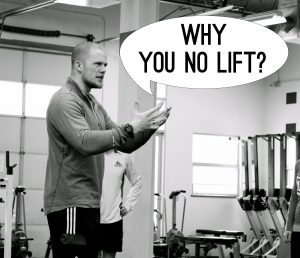
Me, eloquently questioning your lifting habits
Okay seriously…
If you’ve been following along, you know that I am currently writing a series of posts on the reasons for why resistance training is a staple in our both our group and individual programs at MSP Fitness. Far too often the conversation around the water cooler, i.e. internet forums, is less concerned with WHY people ought to lift and more focused on, “shut up and do it already!”, or something to that effect. I stated in the first two posts that you should lift to get stronger and lift to build muscle, what follows is reason number three: training variation.
Training Variation
When it comes to physical exercise, there are several recognized principles of training. One of the most important principles is specificity: train more specifically to elicit the response you desire. In essence, specificity would mean that someone training for a 5 kilometer run ought to be running as part of their training. Now they could bike, swim, even do weight training, but without a dose of specificity, they’re never going to be fully prepared for that 5k race.

Groceries take one trip. A literal form of overload.
In addition to specificity, the second most important training principle is that of overload: doing more than you did last time. In keeping with our 5k run example, our runner would be leaving results on the table if all they did was run five kilometers week after week after week. They are likely going to start small then progress accordingly. This could look like shorter duration runs at a manageable pace in the early weeks of their training, building on the pace and distance as they lead up to the race.
Lastly, and the focus of this blog, is the training principle of variation. While specificity trumps all other training principles, variation is mandatory for adaptation. If we go back to our 5k runner, they are going to see the most benefit by adding variation into the mix. Performing longer runs at lower intensities (long-slow distance work), repeated shorter runs at higher intensities (interval and repetition work), and runs with the same intensity but for a shorter distance (tempo work), would all be examples of program variation in the case of runners.
So far in this blog series, we’ve talked about the benefits of resistance training for getting stronger and building muscle mass. Today, we will speak to resistance training as one of the greatest ways to add variation to your exercise program.
The cat is out of the bag so to say. Everyone and their mom has come out in favor of lifting over the last few years; however, we are still encountering individuals who need convincing and others who simply don’t know where to start. How do I start lifting if I’m training for a road race? A triathlon? An adventure run? What if I’m training for a few less inches around my waist, a little less of that jiggly stuff around the midsection? What about just training to stay out of the grave longer?

Friends don’t let friends buy garbage like this.
If you look back to the principle of variation, you remember that we need variety in training to elicit an adaptive response (i.e. you’ve got to do different stuff to get better). This, however, cannot be mistaken by applying variation for variations sake. The variety that you introduce into your training, has to have purpose. A multi faceted benefit.
 Think of it this way. When I was an intern at the University of Minnesota, head coach to the Olympic programs Cal Dietz explained it this way. The human organism accepts exercise as a stimulus. The response to this stimulus is initially decay. Then, after a period of rest, the organism grows. Anyone who’s worked out knows this. You initially feel beat, but after some rest, recovery, and a consistent effort of putting in the work, you end up better than you ever were before.
Think of it this way. When I was an intern at the University of Minnesota, head coach to the Olympic programs Cal Dietz explained it this way. The human organism accepts exercise as a stimulus. The response to this stimulus is initially decay. Then, after a period of rest, the organism grows. Anyone who’s worked out knows this. You initially feel beat, but after some rest, recovery, and a consistent effort of putting in the work, you end up better than you ever were before.
The stimulus I am applying, in this case: resistance training, is aimed at making the human grow and adapt towards that desired end. For lifters, this could be any of the training goals outlined in part two of this series: strength, power, muscular endurance, or the hypertrophy benefits that come from the stimulus of lifting.
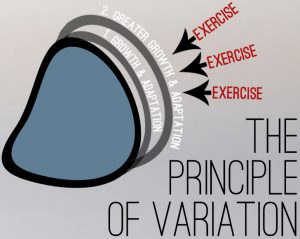 But keep in mind the main reason we include variation. We can’t keep “poking” or stimulating at one, exclusive location forever. Just like our 5k runner can’t just do five kilometer runs to get better, you can’t only do bicep curls to get stronger in the upper body. To foster continued growth, we have to add stimuli from different directions. In variation, what we are looking for is a subtly different stimulus. A form, mode, or type of exercising that’s only marginally different than the one I’m currently applying. So if you were looking to improve upper body strength, you could alter the reps, change up the type of curl, or switch up the exercise to something else entirely.
But keep in mind the main reason we include variation. We can’t keep “poking” or stimulating at one, exclusive location forever. Just like our 5k runner can’t just do five kilometer runs to get better, you can’t only do bicep curls to get stronger in the upper body. To foster continued growth, we have to add stimuli from different directions. In variation, what we are looking for is a subtly different stimulus. A form, mode, or type of exercising that’s only marginally different than the one I’m currently applying. So if you were looking to improve upper body strength, you could alter the reps, change up the type of curl, or switch up the exercise to something else entirely.
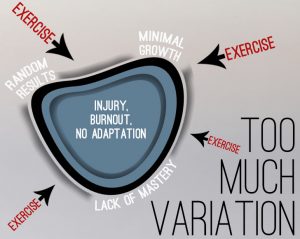 That being said, keep in mind that variety for variety’s sake is ultimately hindering. Too many approaches will lead to burnout, injury, or failure to progress. If our 5k runner starts doing too many different things with not enough transferability to their running, they’ll either ruin the chances of maximum results, or risk injury by stretching themselves too far in opposite directions. No one wants an activity ending injury, and I’d reason to bet no one wants to become the jack of all trades, master of none. It cannot be overstated, too much variation and you’ll break the organism or have no adaptation at all.
That being said, keep in mind that variety for variety’s sake is ultimately hindering. Too many approaches will lead to burnout, injury, or failure to progress. If our 5k runner starts doing too many different things with not enough transferability to their running, they’ll either ruin the chances of maximum results, or risk injury by stretching themselves too far in opposite directions. No one wants an activity ending injury, and I’d reason to bet no one wants to become the jack of all trades, master of none. It cannot be overstated, too much variation and you’ll break the organism or have no adaptation at all.
So where do I start adding variety without ruining myself or my results?
The single best way to start training for a more general training goal is to begin with the stuff you love doing. Especially if the whole fitness thing is new to you. Life experience has shown us, the things you genuinely like to do are the things you’re more than likely going to continue to do. If we apply this to lifting, I personally feel you have to start small with the exercises you don’t actually mind doing, then progress towards lifts that will specifically help you goals.
If you find yourself in that camp of beginners, I would encourage you to start with one or two total body lifting workouts a week. You pick the exercises, just make sure you are covering your bases from head to toe (yes, that includes legs!). Since you’ve selected movements independent of my opinion, there shouldn’t be a begrudging voice in the back of your head keeping you from the gym. These total body workouts can take place on separate days from your other training or be incorporated as a separate session on the same day of training. In keeping with our 5k example, our runner might log some miles in the morning, then get in a resistance training session in the afternoon. On this note, I would discourage putting lifting on the same day as a session of higher intensity (i.e. the aforementioned interval, repetition, or tempo work).
If you are already doing some lifting, might I ask the question, what is it you feel is currently working for you? If you are training for a specific goal, does the lifting you’re doing match that desired end? If I were to program for the person in our 5k example, here’s some places I might start to add lifting variation to their exercise program:
- Single leg exercises
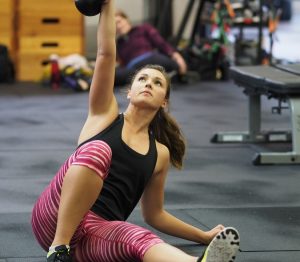
Turkish Get Ups
- Upper body pushing and pulling
- Compound movements such as bilateral squatting, bilateral hinging, as well as barbell pressing
- Anti-rotation work
- Anterior core work, including loaded carries
- Exercises outside the sagittal plane of movement
- Dynamic hip extension work such as kettlebell swings, hang power clean, clean pulls, medicine ball throws and slams)
- Occasional stability training aimed at improving resiliency and preventing injuries
While the above variations were directed towards the runner in our example, I’d encourage you to look at ways to line up your training with your goals so that the variation you include works for you, not against.
Lastly, as we bring this concept of variation full circle, I must recognize that for certain individuals variety is the spice of life. While people cannot be labeled definitively, there are certainly readers of this post who could do the exact same workout every single day and be perfectly happy. Others of you, got anxious at the sheer thought of that last sentence. For many people who are physically training, adding resistance work as variation is that little spice needed to keep training interesting and worthy of pursuing.
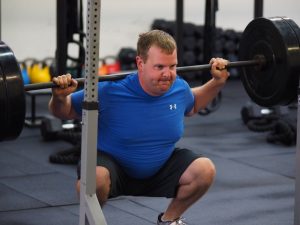 So as we say at MSP fitness, go lift! If you are currently resistance training, add in some of the variations we mentioned above. For those of you who never have, a great place to start lifting is a few of those total body workouts mentioned above. If you are still unsure about a good place to start, what form to implement, or how to progress intensity and load, then I’d recommend seeking out a dedicated coach to help guide you. Our coaches at MSP fitness have the knowledge to apply the training principles discussed in this article, helping you progress to heights you thought were unattainable.
So as we say at MSP fitness, go lift! If you are currently resistance training, add in some of the variations we mentioned above. For those of you who never have, a great place to start lifting is a few of those total body workouts mentioned above. If you are still unsure about a good place to start, what form to implement, or how to progress intensity and load, then I’d recommend seeking out a dedicated coach to help guide you. Our coaches at MSP fitness have the knowledge to apply the training principles discussed in this article, helping you progress to heights you thought were unattainable.
-Written by Taylor Gish


